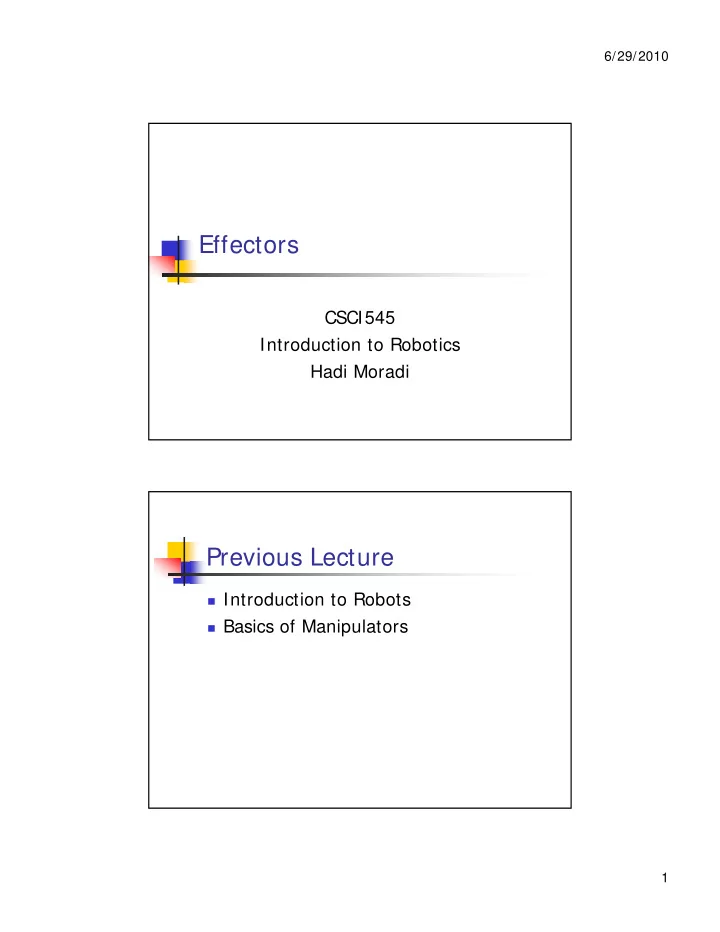

6/29/2010 Effectors CSCI545 Introduction to Robotics Hadi Moradi Previous Lecture � Introduction to Robots Introduction to Robots � Basics of Manipulators 1
6/29/2010 Effector vs. Actuator � Effector: Any device affecting � Effector: Any device affecting the environment. � Actuator: The actual mechanism that brings action h i th t b i ti Actuator Degree Of Freedom (DOF) � The number of independent motions a The number of independent motions a device can make � Examples: � Examples: � Simple sliding 2
6/29/2010 Degree Of Freedom (DOF) � Examples: Examples: � Rotation + translation: Degree Of Freedom (DOF) � Examples: Examples: � A free body in space: 6DOF 3
6/29/2010 Degree Of Freedom (DOF) � Q: How many DOF are � Q: How many DOF are needed to position parts on a planar surface? The Use of Effectors � Locomotion: Moving robot around Locomotion: Moving robot around � Manipulation: Moving other objects � Example: (courtesy of Martin Rohrmeier) � Puma 560 � Puma 560 � Kr6 4
6/29/2010 Locomotion � Types: Types: � Legs � Wheels � Arms � Flippers � … Actuators � Example: Example: � Pneumatic (air pressure) � Hydraulics (fluid pressure) � Give another example! 5
6/29/2010 Actuators � Example: Example: � Motors (current) DC Motors � The most used in mobile robots The most used in mobile robots 6
6/29/2010 DC Motors DC Motor: Permanent Magnet 7
6/29/2010 DC Motors Different DC Motor Confs Image: Courtesy of Paul Hill 8
6/29/2010 DC Motors � Efficiency: Loss on friction � Efficiency: Loss on friction � 90% high end models � 50% low end models � Operating Voltage: DC Motors � Current: proportional to the load � Current: proportional to the load � Pushing toward a wall � Free rotation: � Torque = = rotational force T t ti l f � More current = > 9
6/29/2010 Torque and Power � Stall torque: The amount � Stall torque: The amount of rotational force when stalled. � Power= torque * rotational velocity Torque vs. Power Image: Courtesy of Paul Hill 10
6/29/2010 DC Motor Specs: Iskra 6-pole Torque and Speed � How do you measure torque? How do you measure torque? � How do you measure speed? 11
6/29/2010 Stall Torque calculation Speed � 3,000 to 9,000 RPM 3 000 to 9 000 RPM � Or 50 to 150 RPS � High speed = > � Example: fans � In robotics: � Load should be carried + not very high speed 12
6/29/2010 Gearing � Too much speed: Too much speed: � Cars: � 1000 RPM standby 1000 RPM standby � 3000-6000 Operational Gearing � What is the idea? What is the idea? 13
6/29/2010 Gearing � Two gears meshed together Two gears meshed together Gear Teeth � Backlash: moving back and forth � Backlash: moving back and forth � Reducing backlash = > tight meshing � Problem? � Designing a gear box: � 3:1 speed reduction 3:1 speed reduction � Q: How much reduction can we get? Infinite? 14
6/29/2010 Gear Boxes � Multiple gears in series Multiple gears in series 24 8 24 8 40 Servo Motors � Goal: Goal: � Gear reduction � Position sensor � Position control 15
6/29/2010 Inside a Servo Motor Gears are removed Top cover removed Inside a servo motor 16
6/29/2010 Pulse Width Modulation � 10% duty cycle � 50% duty cycle � 90% duty cycle PWM � 10% of 9 volts = > 0.9 v 10% of 9 volts = > 0 9 v � 50% of 9 volts = > 4.5 v 17
6/29/2010 PWM � How frequently the pulses should be How frequently the pulses should be repeated? � Working frequency: 1KHz – 200 KHz � Note: Stepper Motor vs. Servo Motor � Servo motor: DC motor with position Servo motor: DC motor with position control (feedback/closed loop) � Stepper motor: � Open loop � Many coils: Many coils: 18
6/29/2010 Stepper vs. DC vs. AC � DC motor Stepper motor AC motor Continuous Rotation Motors � Use DC motors Use DC motors � Use servo motors: � Remove mechanical limits � Remove position sensor � Apply two resistors to fool the control � Apply two resistors to fool the control circuit 19
Recommend
More recommend